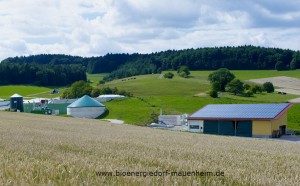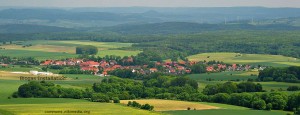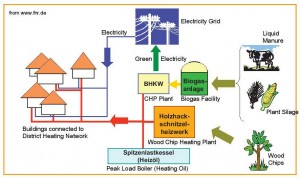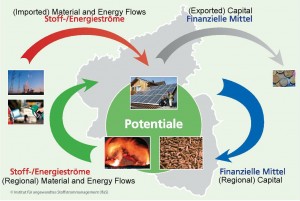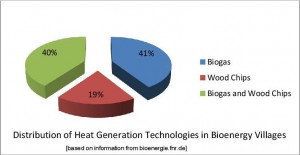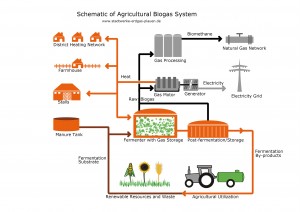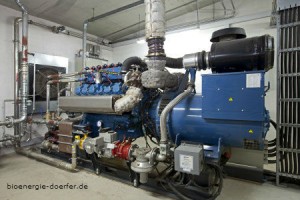Note: this article was originally written for GreenBuildingAdvisor.com.
The notion that a village can produce as much energy as it consumes is not new in Germany, nor is it exclusive to this country that has set aggressive targets for renewable energy use. In the mid-1990s, for example, the Austrian village of Güssing began implementing strategies to use local biomass to produce electricity and heat, and the Danish island community of Samsø installed wind turbines to meet its electrical needs.
In recent years, however, the idea of Bioenergiedörfer, or “bioenergy villages,” seems to have captured the public imagination in Germany. Last month I attended a conference called “Bioenergy Villages 2014” that provided a great overview of the bioenergy village movement in Germany.
A village that produces twice as much power as it consumes
The first village in Germany to be officially recognized as a bioenergy village was Jühnde, in the state of Lower Saxony. In 2005, a cooperative within this village of 780 inhabitants and 450 cows built a biogas production facility fueled by silage plants and manure. The gas from this plant is burned in a communally owned cogeneration plant that provides electricity and heat to buildings in the village. Eventually a wood chip-fired boiler was added to the district heating system to provide supplemental heat.
Every year, thousands of visitors descend on Jühnde to be educated and inspired. These days the town produces over twice as much electricity as it consumes. The citizens are now participating in an electro-mobility pilot project that is exploring ways to use the excess power to serve local transportation needs.
The examples of Jühnde and other early adopters of the bioenergy village concept have encouraged communities throughout Germany to pursue similar strategies. During the past nine years, the knowledge base to support the development of bioenergy villages has grown rapidly. The local and region-wide economic benefits of these villages have also been well documented. There are currently about 150 communities in Germany that are officially registered as bioenergy villages. Hundreds more are in the planning phases.
Determining the precise number of bioenergy villages in Germany is difficult because there is not a single, broadly accepted definition of the term, and because communities are developing their capabilities rapidly. On a website called “Toward the Bioenergy Village”, Germany’s Ministry of Food and Agriculture lists the following criteria for bioenergy villages:
- At least 50% of the community’s energy needs (electricity and heat) are supplied by locally produced bioenergy (typically silage plants and/or wood chips)
- Local citizens are actively involved in developing the ideas and making the decisions
- The biomass used as a resource is owned at least partially by the villagers, and is grown and harvested locally, in a sustainable manner
- Other renewable energy sources may supplement the generation of power and heat from biomass
- Energy efficiency and energy conservation measures are regularly considered and implemented
- Value is created locally, and the benefits extend regionally
A complementary framework for defining bioenergy villages is provided by one of the organizations that sponsored the conference, the Institute for Applied Resource Management. This organization views the development of bioenergy villages in terms of the following five pillars:
- Electricity production
- Heat production
- Energy efficiency
- Land-use management
- Civic engagement
Energy security and affordability
Although bioenergy villages have characteristics in common with one another, they may differ widely in form. As one speaker at the conference put it, “The commonality of bioenergy villages is their broad individuality.” In other words, there is not one prescription for success. Bioenergy villages vary in organizational structure, raw materials used, technology installed, and financing models employed. However, these communities tend to have common goals.
The most frequently expressed motivation for developing a bioenergy village is to ensure the future availability and affordability of energy supplies. Second on the list is to keep money in the local economy. A quote that surfaced several times during the conference comes from 19th century German cooperative pioneer Friedrich Wilhelm Raiffeisen: “Das Geld des Dorfes dem Dorfe” — “the village’s money to the village.”
While environmental concerns certainly play a role in the development of bioenergy villages, surveys reveal that the potential environmental benefits — particularly with regard to climate change — tend not to be the most compelling motivator for many people.
Phased development
Bioenergy villages are typically developed in phases. In its recently published “Guide to the Practical Implementation of Bioenergy Villages” (Bioenergiedörfer: Leitfaden für eine praxisnahe Umsetzung), Germany’s Institute for Renewable Resources (Fachagentur Nachwachsende Rohstoffe) lists these phases as:
- Initiation
- Preliminary Planning and Groundwork
- Detailed Planning and Construction
- Operating and Optimizing
- Further Development
The initial idea for a bioenergy village may come from individuals, from a group within a village, from an agricultural cooperative, or from a local business. The initiators undertake a preliminary assessment of the energy needs of the community, and the potential for these needs to be served by renewable resources. Local residents are surveyed to gauge their interest in participating, and to clarify their motivations. Ideally during this initial phase, a foundation of trust within the community is recognized and strengthened.
Specific questions that are addressed include:
- Does the village have sufficient biomass potential to sustainably support the production of electricity and heat, without competing for other important needs?
- Is there strong interest among the residents to be connected to a district heating network?
- Are there large heat sinks within the community, such as a swimming pool, a school, large town buildings, or industrial facilities that could be integrated into the network?
- Are infrastructure projects such as street improvements, water/sanitation upgrades, or fiber optic installation being planned that could be combined with the burial of district heating pipes?
- On what areas should a feasibility study focus, how should the study be funded, and who within the community will oversee that process?
How big an investment is required?
Data available from bioenergy villages that have been operating for years are available to help guide these initial discussions. For example, the time-frame required to plan and implement a biogas generation plant coupled with cogeneration and a district heating network is typically two to four years.
The initial capital investment for such systems may be between 0.5 and 4 million Euros ($700,000 to $5,500,000). The capital that a village cooperative typically invests is between €50,000 and €500,000 ($70,000 and $700,000). The price that a building owner might pay to connect to the district heating system ranges from €0 to €12,000, with an average cost of about €4,000 ($5,500).
Typically between 50% and 80% of the buildings in a village are connected to the district heating network. Heating costs for residents connected to these networks have been ranging from €100 to €400 ($140 to $550) per year. In terms of land-use, between 100 and 500 hectares (between 250 and 1,200 acres) of forest are required when forestry waste is used to fuel a central boiler. Between 50 and 300 hectares (between 125 and 750 acres) of cultivated land can supply a biogas generator with the silage plants that are typically combined with manure. These numbers are wide-ranging because they depend on a variety of factors such as the size of the village, the configuration of the buildings, and the resources available.
During the “Preliminary Planning and Groundwork” phase, working groups are typically formed to focus on specific areas such as management, technology, biomass, financing and communications. The working group on management develops models for owning and operating the energy systems, and establishes the appropriate legal entities.
The technology working group researches options, visits existing bioenergy installations, and narrows the choice of technologies.
The biomass working group confirms with local producers the sustainable supply of biomass, and develops logistics for harvesting, storage and delivery.
The financing working group investigates subsidies and grants, contacts local banks, and assesses the potential for direct investment from members of the community.
As skillful communication is a cornerstone of successful bioenergy villages, the working group on communications develops and implements a communication plan that encourages participation, emphasizes transparency of process, provides educational resources, and addresses specific concerns of the residents.
Feasibility study
The “Detailed Planning and Building” phase typically starts with commissioning a comprehensive feasibility study that forms the basis of ongoing planning. The feasibility study outlines the extent of the heating network and the capacity of the heating plant. It includes financial, technical and environmental parameters such as annual operating costs, ROI, pipe dimensions, transmission losses, cost increases, and CO2-savings. The calculations include an estimate of the cost of the heat to be supplied to buildings on the network.
In Germany, such feasibility studies might cost €15,000 to €30,000 ($20,000 to $40,000), and take three to six months to complete. While the feasibility study is underway, financing for the project can be lined up. Based on the feasibility study, agreements are executed with the biomass suppliers, the contractors who will build the energy production and distribution systems, and the consumers of the heat and power. With the appropriate contracts in place, the design and engineering are finalized, and construction can begin.
“Operating and Optimizing” a village-scale energy system requires ongoing training of personnel, troubleshooting issues that arise, and adjusting the system for optimal performance. As new buildings are constructed and more resources become available, additional buildings can be connected to the district heating network. Improvements to the efficiency of system components are also made — for example by reducing the heating requirement of buildings in the village, or improving the efficiency of pumps.
“Further Development” takes many forms, including the implementation of innovative technologies and programs (process heat for commercial/industrial use, eco-tourism, electro-mobility, etc.), the installation of photovoltaic arrays and wind turbines, the construction of additional biogas generators and cogeneration plants, and region-wide outreach and education.
Allaying local concerns
While these phases provide a convenient outline for planning the development of a bioenergy village, the reality is not so neat or predictable. Challenges to the process — both legitimate and ill-informed — can arise at every stage. Doubts will be raised about the projected costs, the efficiency and reliability of the installations, the potential environmental impacts, and disruption due to truck traffic.
The Bioenergiedörfer movement in Germany has accumulated a wealth of experience to allay these concerns. Additional guidance is provided by studies of bioenergy villages that have identified common factors contributing to success, including:
- One or more Zugpferde (“draft horses”) — citizens who tirelessly champion the project
- A strong sense of community spirit and trust
- Clear and frequent communication, and transparent processes
- Broad and strong engagement of community members
- A comprehensive and reliable feasibility study
- Efficient and determined planning and implementation
- Relatively low connection costs to the district heating system
- Resultant heating costs that are competitive with (or lower than) the status quo
One additional success factor is the ability of bioenergy village residents to see their community as a role model that can instruct and inspire other villages in the region and beyond. Several presenters at the conference suggested that a critical mass of experience and capability is being reached that could significantly accelerate the development of bioenergy villages.
However, this optimism was tempered at the conference by pointed references to the government’s current discussions about revising the law that provides financial incentives for renewable energy production — the so-called EEG 2.0. In order to try to curb what many perceive as unsustainable increases in the retail cost of electricity, the government may cut some of these incentives. Biogas installations and cogeneration plants are seen as potential losers in these negotiations.
Scaling the concept
As the number of bioenergy villages in Germany increases, attention is increasingly being paid to scaling these efforts to regions, towns, and cities. The conference presenters showcased a number of towns and cities that have built on the concept of the bioenergy village. These larger communities typically have multiple cogeneration units fueled by biogas and natural gas that provide heat and power to neighborhoods and to complexes of buildings such as hospitals and schools. Photovoltaic arrays and wind turbines often contribute to the supply of locally produced power.
In addition to being broadened geographically, the concept of bioenergy villages is being recognized as having diverse demographic benefits. I was struck at this conference, as I have been at others here in Germany, by the way in which themes relating to social justice are brought into discussions about renewable energy and energy efficiency. (Any American who thinks that Obama is a socialist should try living in Europe for a while).
Like many other countries, Germany is seeing a general migration of young people from rural to urban areas. By creating jobs and fostering innovation, bioenergy villages provide opportunities for rural youth. The conference presentations highlighted numerous examples of villages that have been re-energized and re-capitalized through their own efforts.
At the other end of the demographic spectrum, retirees in these villages are often living on fixed incomes that have been outpaced by increases in the cost of electricity and heat. Stabilizing the cost of utilities is particularly helpful to the elderly and the poor, who spend a relatively high proportion of their income on these basic necessities.
While the measurable benefits of bioenergy villages are well-documented, a less tangible but oft-mentioned outcome is the sense of empowerment that is shared by the villagers. Communities take pride in creating their own electricity and heat, in reducing Germany’s dependence on foreign energy suppliers (read: Russia, lately), and in helping to achieve the goals of the country’s ambitious Energiewende, or Energy Transition.
Could we do it here?
What lessons do Germany’s bioenergy villages hold for the U.S.? I have been pondering this question with regard to my own community and region. I live in a section of the Connecticut River Valley that was once characterized by thriving manufacturing communities — the so-called Precision Valley. I see similarities between the villages — some of them struggling — in New Hampshire and Vermont with which I am familiar, and many of the rural villages I have seen in Germany — especially those in the former East Germany.
The challenges of translating Germany’s success with bioenergy villages to New England are admittedly substantial. Germany’s rural villages tend to be very compact, surrounded by open farmland. Americans like to spread out. Although the German government has not specifically targeted bioenergy villages for financial support, many of the Energiewende’s programs encourage investment in the renewable energy systems on which bioenergy villages are based.
Technologies that are common in Germany, such as biogas installations (roughly 8,000 to date), village-scale cogeneration plants, and district heating systems, have not been widely implemented in the U.S. Lower retail electricity prices in the U.S. make cogeneration potentially less attractive, and the availability of natural gas has undoubtedly hampered development of the biogas industry.
Culturally, Germans generally seem to value consensus and cooperative action more than we do in the U.S. This cultural bias can be seen in the realm of national politics as well as in local communities.
Despite the differences between Germany and the U.S. in the geographic, political, technological, and cultural landscapes, the fundamental lesson that I take from Germany’s bioenergy village movement is that success is possible, and even likely, given sufficient commitment from residents. The details of historic New England villages becoming net positive producers of energy will undoubtedly differ from those of Germany’s Bioenergiedörfer, but the compelling benefits will be similar.

